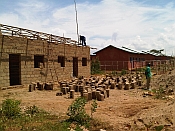
The Auditor General in Rwanda this week reported that funds utilised by the Government Assistance Fund for Survivors (FARG) for the construction of shelter is “not worth the amount of money spent“. Between 2006-2008 alone, 6 billion Rwandan Francs (approximately £6 million) was transferred by FARG to local districts for the construction of houses or used for the purchase of construction materials.
Amongst his findings, the Auditor General reports that “a total of 1,090 eligible individuals selected to receive construction materials did not get them in five districts surveyed, yet 835 others who were not previously on the approved list obtained the materials.” He also reports that a stock of 37 tonnes of roofing nails worth Rwf 31million (£30,000) was still in the Local Government Ministry’s stores by September 2010, yet some of the beneficiaries who received iron sheets did not receive nails.
It is not an easy task to build houses in Rwanda, though with a £1 million grant from Comic Relief over the same period, Survivors Fund (SURF) succeeded in constructing 362 houses for 1,810 survivors (part of a larger housebuilding programme, showcased in this short film). The project did not deliver shelter alone, but recognised that for the impact of such a project to be sustained, it required beneficiaries to be empowered to care for their houses. As such a holistic intervention was designed which provided vocational training and income generating activities to ensure that beneficiaries were able to develop a livelihood, and in so doing generate the income necessary for the upkeep of the houses.
In not every case has this been successful, and five years on from the construction some of the houses have required additional work for repairs and rehabilitation. Some of the companies that undertook the construction delivered sub-par work which has resulted in problems too. However, the project overall delivered well constructed houses that continue to provide shelter still vitally required by so many survivors. In the spirit of full disclosure, we publish the full report of that project here.
FARG reports that it has constructed 14,857 houses for survivors at a cost of FRW 8 billion (£8 million), which is a remarkably low cost per unit (of £540 per house). As such, it is only right that questions should be raised over the quality of the housing today.
The challenge ahead is now to asses the shelter situation of these survivors, and how many of those houses are still fit for purpose. Funding for shelter will be phased out by FARG over the next two years, once the remaining 3,000 survivors still on their list receive support. In light of the mistakes and problems reported by the Auditor General this week, it will be critical to ensure that the shelter these survivors receive is adequate too.
